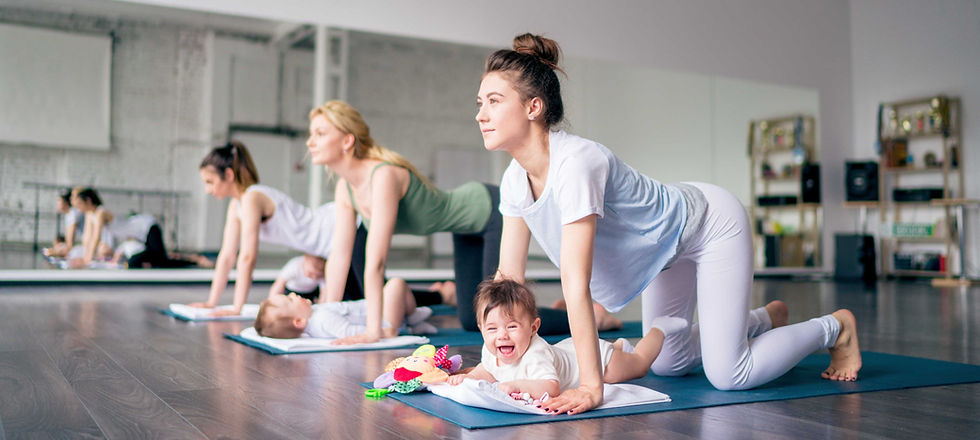
Congratulations, you’ve met your baby! Over the months after your baby is born, your body gradually begins to recover from the strain of carrying the baby and giving birth. While you may feel rushed off your feet dealing with the new arrival, it is worth trying to make time for postnatal exercise. Postnatal exercise classes are designed to promote postpartum healing and help your body to handle the practicalities of being a mum, you may even be able to bring the baby along to avoid worries about childcare.
Pelvic floor exercises
You may have restarted your pelvic floor exercises as soon as your baby was born, or you may have felt exhausted and overwhelmed and decided to wait a few days (which became a few more, until you forgot entirely…). If you forgot, I’m with you.
Unfortunately, our pelvic floor muscles get stretched and strained by carrying and delivering the baby, and without actively engaging them it is very difficult to regain your muscle tone. While we rarely go to the gym to try and get a “toned pelvic floor”, weak pelvic floor muscles mean reduced bladder control. Unless you take time to strengthen your pelvic floor after childbirth you may be left with a long term reduction in bladder control, which worsens as you age. Alternatively, you can start now and take a few minutes every day to complete basic pelvic floor exercises, while you brush your teeth, make a cup of tea or feed your baby, and you’ll rapidly regain strength and control.
Diastasis Recti and abdominal muscles
As your baby grows inside you, the tissue connecting the abdominal muscles on either side of your body is stretched and the abdominal muscles are pushed away from each other – this is called Diastasis Recti. This means (even without a c-section) your abdominal muscles are much weaker than they were before your pregnancy and you may be feeling the strain in your back. Before you go back to your favourite pre-baby exercise (running, weights, trampolining), it’s a good idea to rehabilitate your abdominal muscles.
Postnatal Pilates is an ideal way to restore your core strength and pelvic floor muscles: gradually building up strength and using your muscles in the right way. Overdoing it too soon can prevent your abdominal separation from healing; some exercises encourage your abs to push outwards and slow abdominal healing. If you’re not working with a postnatal qualified trainer or in a postnatal only class you may be overloading your abs and delaying your healing. Once your abdominal muscles and pelvic floor are back in shape you should be able to go back to your usual exercise routines.
Aches and stiffness
It is common for new mums to experience stiffness and aches, but that doesn’t mean you should suffer in silence. If you’re experiencing frequent pain or discomfort it is always worth checking it out with a medical professional.
If it is just stiffness, then take time to mobilise and stretch: open out tight chest muscles, gently move your neck and spine and release tension in your shoulders.
What else does your body need?
Your body needs to be strong to deal with the demands of being a mum. Most of us lose strength and fitness during our pregnancy, even if you have an “easy” pregnancy and keep exercising throughout your pregnancy, it isn’t possible to maintain full strength and fitness. Strength in your glutes (bottom) and legs will help to support your back while you rehabilitate your core, as well as to push your pram and carry the weight of your baby.
When can I start?
Unless you’re already receiving specific advice about pelvic floor care after your birth, do your pelvic floor exercises every day, three or four times a day, starting now.
For all other exercise, the time to begin is when you feel mentally and physically ready. When you have your GP check-up after birth it’s a good time to ask them for clearance to exercise, they may not mention exercise unless you ask! If you have a vaginal delivery you’ll likely have a check up at around 6 weeks, if you have a c-section it will be at 8-12 weeks. Here are some things to consider:
· Have you stopped bleeding?
· Have your scars healed?
· Are you able to walk for 10 minutes without pain?
If you can say yes to all these, you’re eating, drinking and sleeping (at least a little) then you’re probably ready. If you’re still working up to making a cup of tea, give yourself a little longer; concentrate on gentle walks and self-care for now.
What should I do?
Look for a postnatal qualified trainer or class to help you build up your strength and fitness safely and gradually. Postnatal Pilates is ideal for rehabilitating your core muscles, building strength and stretching stiff muscles. You can choose one-to-one sessions or group classes with other mums and babies; check out the group timetable or contact me to discuss one-to-one sessions.

Comentários